Lab-grown diamonds have become increasingly popular over the last few years. While they’ve been around since the 50s, they’ve only recently become widely available and affordable. Alongside being less expensive, lab-grown diamonds are also more ethical and sustainable.
But despite their growing popularity, some remain sceptical of their quality and durability. For many, there’s still a strong preference for natural diamonds. But what’s the difference between natural and lab-grown diamonds? Are there any reasons to choose one over the other?If you’re planning to propose, looking for a wedding ring or searching for a unique gift, you’ll probably need to choose between natural and lab-grown diamonds. This guide will give you the lowdown on the differences and help you decide which is right for you.
What is a natural diamond?
Natural diamonds form deep within the Earth's mantle at high temperatures and pressures. Geological processes such as plate tectonics and volcanic eruptions carry them to the surface. Once a diamond rises to the Earth's surface, it's mined and cut to create the diamonds we recognise.
A natural diamond is a mineral of carbon atoms arranged in a crystal lattice. Diamonds are the hardest known material on Earth. While diamonds are best known for their use in jewellery, many industries use them.
The type and amount of impurities present in the crystal structure determine the colour of a diamond. The most common colours are yellow, brown, and white, but you can also find blue, green, red, and pink diamonds.
What is a lab-grown diamond?
Unsurprisingly, a lab-grown diamond is a diamond created in a laboratory. Creating a lab-grown diamond is similar to how natural diamonds form. The process uses high pressure and high temperature to compress carbon atoms into a diamond crystal.
But the creation of lab-grown diamonds takes a fraction of the time natural diamonds take to form — usually a few months. As a result, lab-grown diamonds are becoming a popular alternative to natural diamonds. As well as being more environmentally friendly, lab-grown diamonds are often less expensive.
So, what’s the difference?
With lab-grown diamonds becoming increasingly popular and affordable, more people are choosing them over natural diamonds. But beyond how they’re made, what are the differences between these two types of diamonds?
Appearance
Let’s be honest, it’s the appearance of a diamond that matters most when we’re buying jewellery. Lab-grown diamonds are identical to natural diamonds physically and chemically. They offer the same beauty, durability, and clarity that has made diamonds one of the most popular gemstones in the world.
You’d be hard-pressed to tell the difference with the naked eye, and even some experts struggle. So if you’re buying a diamond ring for an engagement or as a gift, there’s very little chance anyone will be able to tell the difference — unless you tell them.
Value
Natural diamonds are much rarer, giving them a higher market value. Natural diamonds also have slight colour variations that impact their value. In contrast, lab-grown diamonds are usually perfectly colourless.
It’s also important to note that natural diamonds have been used for centuries as a symbol of love and commitment, whereas lab-grown diamonds are a relatively new phenomenon. As a result, natural diamonds tend to carry more emotional value.
Sustainability and ethics
Natural diamonds form over millions of years. They are then mined from the Earth and cut into the gems we love. The problem with natural diamonds is that mining can be destructive to the environment. But there are also ethical issues surrounding natural diamonds. These issues include violence and child labour.
On the other hand, lab-grown diamonds are created in a laboratory using advanced technology. While this process requires a significant amount of energy, it does not harm the environment as mining does. Plus, most lab-grown diamonds are ethically sourced since they are manufactured rather than mined.
Choosing between natural or lab-grown diamonds
For many people, the choice between a lab-created diamond and a natural diamond comes down to price. Lab-created diamonds are often less expensive, which makes them a more budget-friendly option.
But ultimately, whether to buy a lab-created or a natural diamond is a personal one. There’s no right or wrong answer, but it’s crucial to weigh the pros and cons before making a purchase.
*Collaborative post







No comments